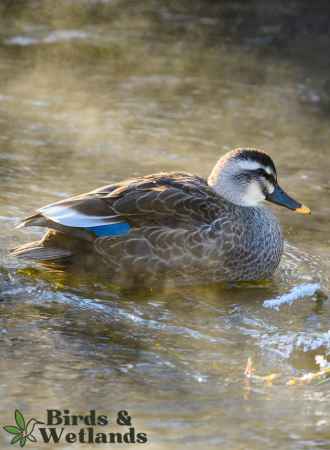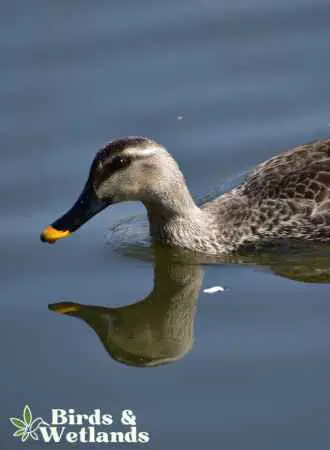The eastern spot-billed duck (Anas zonorhyncha), also known as the Chinese spot-billed duck, is a dabbling duck native to East and Southeast Asia.
It was previously classified as a subspecies of the Indian spot-billed duck. Both ducks were referred to as spot-billed ducks.
Its common name is derived from the obvious yellow spot on its bill.
Scientific Name: Anas zonorhyncha
Height: 55–63 cm (22–25 in)
Wingspan: 83–95 cm (33–37 in)
Weight: 790–1,500 g (1.74–3.31 lb)
Physical Description

- Mainly a dark grey-brown color with a paler head and neck and whitish to the buffy-white breast.
- Scaly patterned body
- Black-tipped, bright yellow tip or band on its bill
- White wings with black flight feathers, looks a white-bordered green from above
- Bright orange legs and feet
- An eye-catching blue speculum is visible in flight
- Males and females undergo molt, losing all their wing feathers simultaneously.
- Males don’t have eclipse plumage.
Listen to the Eastern Spot-Billed Duck
Habitat & Range

The Eastern Spot-billed Duck is a highly migratory species that breeds throughout East Asia, including the Russian Far East, eastern Mongolia, Sakhalin Island, North and South Korea, and Japan.
In the winter, these ducks fly as far south as Thailand, Cambodia and the northern parts of the Philippines.
These ducks are typically found in freshwater lakes and marshes in fairly open country with plenty of emergent vegetation. They prefer open habitats at low elevations but have been known to migrate to elevations as high as 3,300 meters in southwest China.
The eastern spot-billed duck forms small flocks. Observations conducted in southern China found that these ducks winter with the Indian spot-billed duck.
The eastern spot-billed duck is rarely observed in North America, with a few sightings reported in the Aleutian Islands and other parts of Alaska.
Behavior & Diet
The eastern spot-billed duck is an omnivorous waterfowl that primarily feeds on seeds, aquatic plants, and small animals such as insects and their larvae. They have also been known to eat higher-nutrition foods such as crab meat or small fish when given the opportunity.
While their main diet consists of seeds and aquatic vegetation, the specific plant food they consume may vary depending on the season and location.
These ducks feed by dabbling or upending in shallow bodies of water and may also forage on land in marshy areas.
Nesting & Mating Habits

Eastern spot-billed ducks are monogamous, with males engaging in elaborate courtship displays to attract mates. The breeding season varies depending on rainfall and water condition. It normally occurs between early April and late July.
Regarding nesting habits, these grey ducks prefer sites near bodies of water such as lakes or marshes. However, they also nest amongst grasses away from water sources if their preferred nesting sites are unavailable.
The nests vary greatly across regions but are typically constructed from tall vegetation such as reeds or cattails. The nest is lined with down feathers and soft plant materials.
The female lays between 7 to 10 grayish-white eggs, and incubation begins as soon as the last egg is laid. The young hatch between 25 to 30 days. The eggs hatch simultaneously. The ducklings have black down with a yellow back.
Interestingly, hybridization is a regular occurrence in Eastern Russia, where males regularly mate with female mallards. Mixed pairs in this region are not uncommon.
Threats & Conservation

The eastern spot-billed duck is currently assigned the conservation status of “Least Concern.”
Nevertheless, this species is threatened by various human activities, such as hunting and habitat destruction. Hunting pressure has taken its toll on this species, reducing population numbers in some parts of its range. As a result, the global population of this species is estimated to be declining at a moderate rate.
Many countries have enacted legislation prohibiting or regulating hunting practices for this species. Some areas have designated protected zones where hunting is not allowed to provide refuge for breeding populations of ducks.
Key Points
- The eastern spot-billed duck was previously classified as a subspecies of the Indian spot-billed duck but was promoted to species status. It is now a separate species.
- It is a dabbling duck native to East and Southeast Asia.
- It has a yellow spot on its bill, which gives it its common name.
- These ducks migrate to Thailand, Cambodia, and the Philippines in the winter.
- They are typically found near freshwater lakes and marshes.
- Eastern spot-billed ducks are monogamous and engage in vocal courtship rituals.

